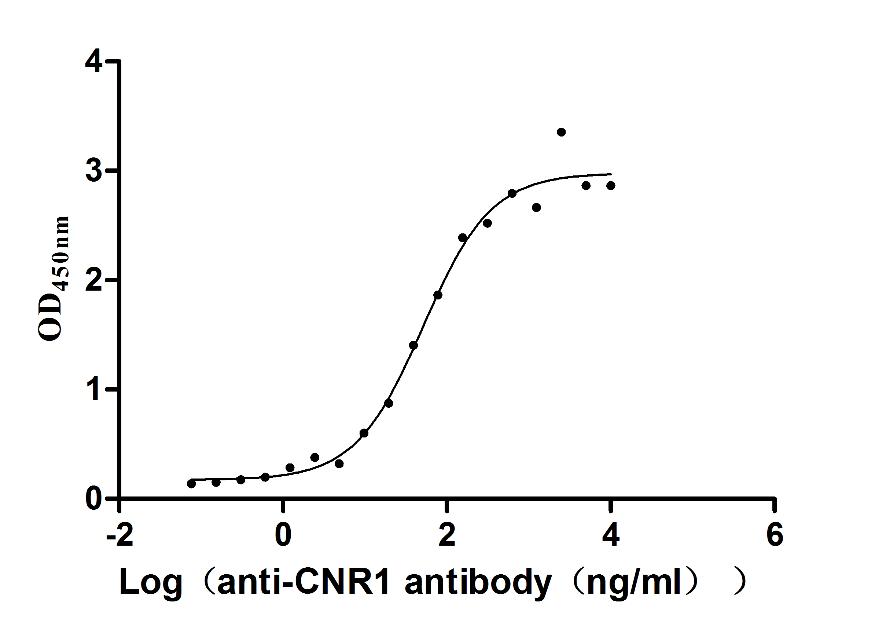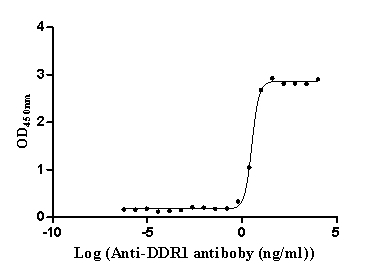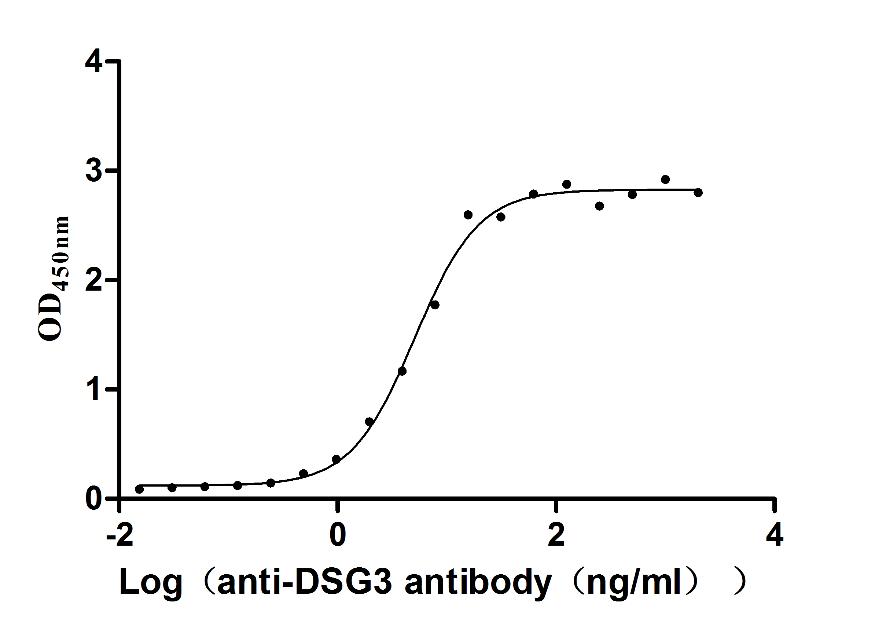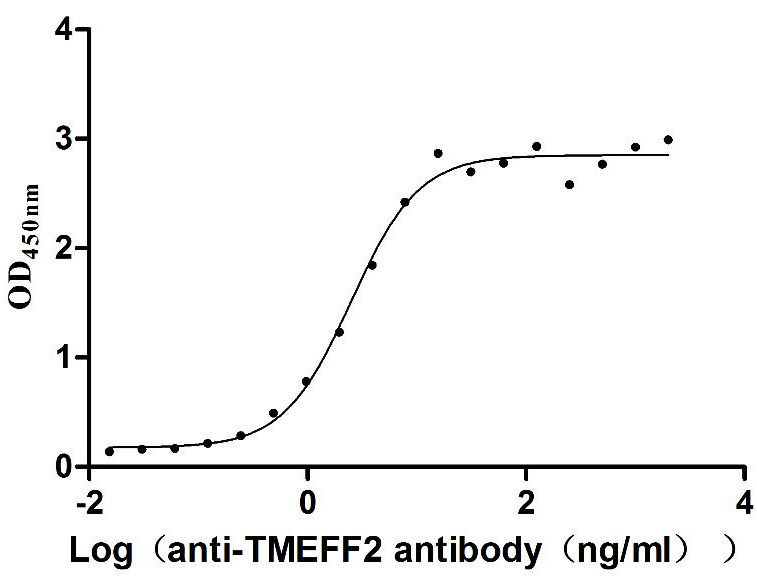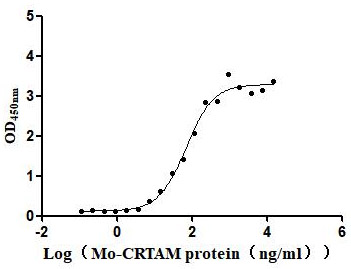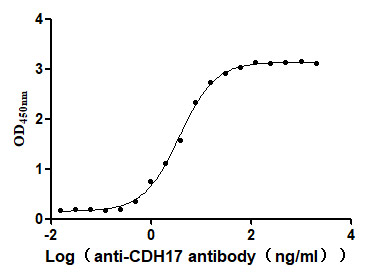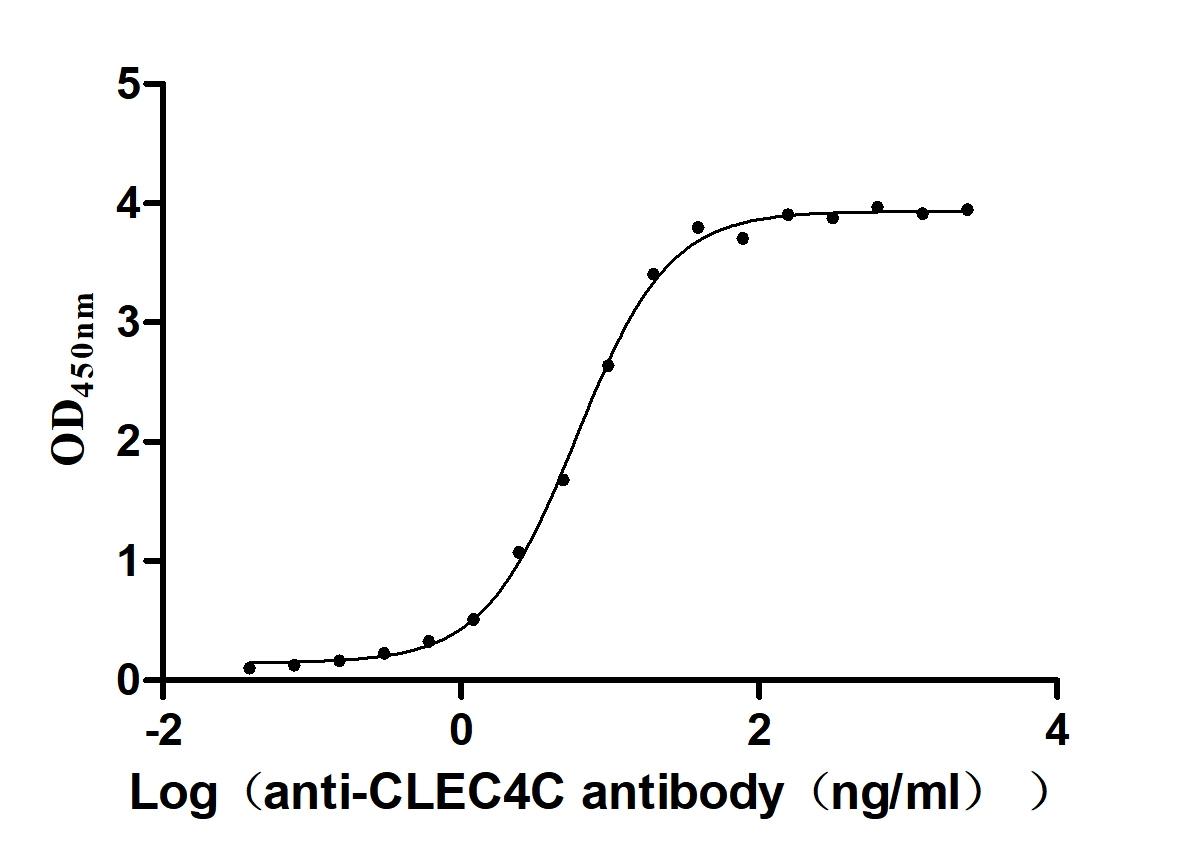Recombinant Mouse Receptor-type tyrosine-protein phosphatase alpha (Ptpra), partial
-
中文名稱:小鼠Ptpra重組蛋白
-
貨號:CSB-YP019047MO
-
規格:
-
來源:Yeast
-
其他:
-
中文名稱:小鼠Ptpra重組蛋白
-
貨號:CSB-EP019047MO
-
規格:
-
來源:E.coli
-
其他:
-
中文名稱:小鼠Ptpra重組蛋白
-
貨號:CSB-EP019047MO-B
-
規格:
-
來源:E.coli
-
共軛:Avi-tag Biotinylated
E. coli biotin ligase (BirA) is highly specific in covalently attaching biotin to the 15 amino acid AviTag peptide. This recombinant protein was biotinylated in vivo by AviTag-BirA technology, which method is BriA catalyzes amide linkage between the biotin and the specific lysine of the AviTag.
-
其他:
-
中文名稱:小鼠Ptpra重組蛋白
-
貨號:CSB-BP019047MO
-
規格:
-
來源:Baculovirus
-
其他:
-
中文名稱:小鼠Ptpra重組蛋白
-
貨號:CSB-MP019047MO
-
規格:
-
來源:Mammalian cell
-
其他:
產品詳情
-
純度:>85% (SDS-PAGE)
-
基因名:Ptpra
-
Uniprot No.:
-
別名:Ptpra; Lrp; Ptpa; Receptor-type tyrosine-protein phosphatase alpha; Protein-tyrosine phosphatase alpha; R-PTP-alpha; EC 3.1.3.48; LCA-related phosphatase; PTPTY-28
-
種屬:Mus musculus (Mouse)
-
蛋白長度:Partial
-
蛋白標簽:Tag?type?will?be?determined?during?the?manufacturing?process.
The tag type will be determined during production process. If you have specified tag type, please tell us and we will develop the specified tag preferentially. -
產品提供形式:Lyophilized powder
Note: We will preferentially ship the format that we have in stock, however, if you have any special requirement for the format, please remark your requirement when placing the order, we will prepare according to your demand. -
復溶:We recommend that this vial be briefly centrifuged prior to opening to bring the contents to the bottom. Please reconstitute protein in deionized sterile water to a concentration of 0.1-1.0 mg/mL.We recommend to add 5-50% of glycerol (final concentration) and aliquot for long-term storage at -20℃/-80℃. Our default final concentration of glycerol is 50%. Customers could use it as reference.
-
儲存條件:Store at -20°C/-80°C upon receipt, aliquoting is necessary for mutiple use. Avoid repeated freeze-thaw cycles.
-
保質期:The shelf life is related to many factors, storage state, buffer ingredients, storage temperature and the stability of the protein itself.
Generally, the shelf life of liquid form is 6 months at -20°C/-80°C. The shelf life of lyophilized form is 12 months at -20°C/-80°C. -
貨期:Delivery time may differ from different purchasing way or location, please kindly consult your local distributors for specific delivery time.Note: All of our proteins are default shipped with normal blue ice packs, if you request to ship with dry ice, please communicate with us in advance and extra fees will be charged.
-
注意事項:Repeated freezing and thawing is not recommended. Store working aliquots at 4°C for up to one week.
-
Datasheet :Please contact us to get it.
靶點詳情
-
功能:Tyrosine protein phosphatase which is involved in integrin-mediated focal adhesion formation. Following integrin engagement, specifically recruits BCAR3, BCAR1 and CRK to focal adhesions thereby promoting SRC-mediated phosphorylation of BRAC1 and the subsequent activation of PAK and small GTPase RAC1 and CDC42.
-
基因功能參考文獻:
- PTPalpha coordinates oligodendroglial and neuronal development and myelination. PMID: 28647856
- RPTPalpha mediates proinflammatory and proinvasive signaling in rheumatoid arthritis fibroblast-like synoviocytes (FLS), correlating with the promotion of disease in an FLS-dependent model of rheumatoid arthritis. PMID: 26414708
- Ptpra coordinates the regulation of the Fyn signaling pathway in corpus striatum. PMID: 25951993
- PTPs alpha and epsilon play distinct roles in osteoclasts. PMID: 24694598
- PTP-alpha promotes profibrotic signaling pathways in fibroblasts through control of cellular responsiveness to TGF-beta. PMID: 24650563
- The focal adhesion targeting domain of FAK interacts with protein-tyrosine phosphatase-alpha to restrict IL1-induced Ca2+ release, ERK activation, and MMP-9 expression. PMID: 24821720
- PTPalpha may be involved in the formation of axoglial junctions and ensheathment in small axons during myelination of the spinal cord. PMID: 23934023
- Findings indicate Grb2 as a new FAK activator and in coordinating PTPalpha tyrosine phosphorylation to enable downstream integrin signaling and migration. PMID: 24248601
- Results suggest that inhibition of PTPalpha can have a beneficial effect on HER2-positive breast cancers, but that inhibition of additional targets is needed to block breast tumorigenesis. PMID: 23318421
- Inflammation-induced connective tissue degradation involving fibroblasts requires functionally active PTPalpha. PMID: 23940616
- study described a molecular complex of PTPalpha-BCAR3-Cas-Src; this complex forms in response to PTPalpha Tyr789 phosphorylation and mediates Cas localization to focal adhesions and Cas downstream signaling to promote cell migration PMID: 22801373
- Protein-tyrosine phosphatase alpha acts in oligodendrocyte progenitor cells to limit self-renewal and facilitate differentiation. PMID: 22354965
- protein kinase C and protein tyrosine phosphatase alpha participate in Src activation by 1alpha,25OH2 vitamin D3 in C2C12 skeletal muscle cells PMID: 21459125
- the PTPalpha-mediated increase of NB-3 level at the cell surface represents a novel function of PTPalpha in NB-3 signaling in neural development PMID: 21622556
- these findings indicate that PTPalpha acts as an Ag-stimulated Lyn-Fyn phosphatase and a critical positive regulator of these Src family kinases in FcepsilonRI signaling PMID: 20944008
- The results suggest that transformation by PTPalpha involves at least one function other than, or in addition to, its activation of Src and that this depends on PTPalpha's extracellular domain. PMID: 20545765
- Expression of CD45RA and -RC isoforms is increased 20- to 200-fold on T cells from mice with a loss-of-function mutation in RNA-binding protein heterogeneous nuclear ribonucleoprotein L-like, although total CD45 expression is unaltered. PMID: 20505149
- Results describe the role of nitric oxide in regulating the focal adhesion proteins, Src, FAK, p130 Cas, and PTP-alpha. PMID: 20055753
- A new model for mitotic activation of Src in which PP2A-mediated dephosphorylation of RPTPalpha pSer204 facilitates Src binding, is proposed. PMID: 20385765
- Findings demonstrate that PTPalpha is a critical regulator of Fyn activation and of specific Fyn signaling events during differentiation, and is essential for promoting OPC differentiation and central nervous system myelination. PMID: 19812040
- Mitotic activation of protein-tyrosine phosphatase alpha and regulation of its Src-mediated transforming activity by its sites of protein kinase C phosphorylation PMID: 11923305
- RPTPs have the capacity for inside-out signaling PMID: 12582170
- protein tyrosine phosphatase PTP alpha has a role in induction of src kinase via protein kinase C PMID: 12826681
- RPTRalpha is essential for hippocampal neuronal migration and long-term potentiation. PMID: 12912911
- PTPalpha knockout mice show decreased anxiety without an increase in head dips and stretch-attend movements; during Morris water maze learning, PTPalpha-/- mice have increased latencies to reach the goal, but no memory deficit on probe trials. PMID: 12932834
- PTPalpha is not a negative regulator of insulin signaling and does not perform an essential role in mediating the physiological action of insulin PMID: 14733908
- Data show that the NCAM140 isoform directly interacts with the intracellular domain of the receptor-like protein tyrosine phosphatase RPTPalpha, a known activator of p59fyn PMID: 15623578
- PTPalpha is a component of the complex Src family tyrosine kinase regulatory network in thymocytes and is required to suppress Fyn activity in unstimulated cells in a manner that is not compensated for by the major T cell PTP and SFK regulator, CD45. PMID: 16339530
- We conclude that PTPepsilon and PTPalpha differ significantly in their regulation of Kv channels and Src in the system examined and that similarity between PTPs does not necessarily result in full functional redundancy in vivo. PMID: 16870705
- Defective NMDAR activity in protein tyrosine phosphatase alpha(PTPalpha) deficiency may be linked to loss of PTPalpha as upstream regulator of proline-rich tyrosine kinase 2. PMID: 16899073
- Exposure of RPTPalpha D2 to oxidants promotes formation of a cyclic sulfenamide species, a reversibly oxidized state of Cys723, accompanied by conformational changes of the D2 catalytic site. PMID: 17223692
- LAR regulates IGF-1R signaling in vascular smooth muscle cells PMID: 17500057
- PTPalpha and PTPalpha-Y789F have distinct activities in T cells and CD45 is a regulator of PTPalpha phosphorylation at tyrosine 789 in T cells PMID: 17507376
- Data show that RPTPalpha is required for rigidity-dependent reinforcement of fibronectin (FN)-cytoskeleton bonds and the rigidity response in hippocampal neuron growth cones. PMID: 17940065
- Mediates close homolog of L1 (CHL1) and contactin-6 (NB-3)-regulated apical dendrite projection in the developing caudal cortex. PMID: 18046458
- RPTPalpha plays a critical role in HCN channel function via tyrosine dephosphorylation PMID: 18768480
- Activation of c-Src and Fyn kinases by protein-tyrosine phosphatase RPTPalpha is substrate-specific and compatible with lipid raft localization. PMID: 18948260
- Protein tyrosine phosphatase-alpha complexes with the IGF-I receptor and undergoes IGF-I-stimulated tyrosine phosphorylation that mediates cell migration. PMID: 19420001
- PTPalpha acts as an adaptor to mediate functional links between focal adhesions and the endoplasmic reticulum that enable IL-1-induced Ca2+ signaling. PMID: 19497848
顯示更多
收起更多
-
亞細胞定位:Cell membrane; Single-pass type I membrane protein. Cell junction, focal adhesion.
-
蛋白家族:Protein-tyrosine phosphatase family, Receptor class 4 subfamily
-
組織特異性:Widely expressed. Highest expression in brain and kidney.
-
數據庫鏈接:
Most popular with customers
-
Recombinant Rat Intestinal-type alkaline phosphatase 1 (Alpi) (Active)
Express system: Mammalian cell
Species: Rattus norvegicus (Rat)
-
Recombinant Human Cannabinoid receptor 1 (CNR1)-VLPs (Active)
Express system: Mammalian cell
Species: Homo sapiens (Human)
-
Recombinant Human Epithelial discoidin domain-containing receptor 1 (DDR1), partial (Active)
Express system: Mammalian cell
Species: Homo sapiens (Human)
-
Recombinant Human Desmoglein-3 (DSG3), partial (Active)
Express system: Baculovirus
Species: Homo sapiens (Human)
-
Recombinant Human Tomoregulin-2 (TMEFF2), partial (Active)
Express system: Mammalian cell
Species: Homo sapiens (Human)
-
Recombinant Mouse Cell adhesion molecule 1 (Cadm1), partial (Active)
Express system: Mammalian cell
Species: Mus musculus (Mouse)
-
Recombinant Human Cadherin-17 (CDH17), partial (Active)
Express system: Mammalian cell
Species: Homo sapiens (Human)
-
Recombinant Macaca fascicularis C-type lectin domain family 4 member C(CLEC4C), partial (Active)
Express system: Mammalian cell
Species: Macaca fascicularis (Crab-eating macaque) (Cynomolgus monkey)



